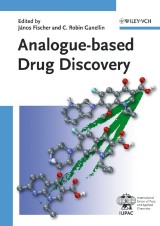Details

Analogue-based Drug Discovery
1. Aufl.
|
228,99 € |
|
| Verlag: | Wiley-VCH |
| Format: | |
| Veröffentl.: | 13.12.2006 |
| ISBN/EAN: | 9783527607495 |
| Sprache: | englisch |
| Anzahl Seiten: | 606 |
DRM-geschütztes eBook, Sie benötigen z.B. Adobe Digital Editions und eine Adobe ID zum Lesen.
Beschreibungen
The first authoritative overview of past and current strategies for successful drug development by analog generation, this unique resource spans all important drug classes and all major therapeutic fields, including histamine antagonists, ACE inhibitors, beta blockers, opioids, quinolone antibiotics, steroids and anticancer platinum compounds. <br> Of the 19 analog classes presented in detail, 9 are described by the scientists who discoverd them.<br> The book includes a table of the most successful drug analogs as based on the IMS ranking and compares them in terms of chemical structure, mode of action and patentability.
Introduction<br> GENERAL ASPECTS OF ANALOGUE-BASED DRUG DISCOVERY<br> Analogues as a Means of Discovering New Drugs<br> Drug Likeness and Analogue-Based Drug Discovery<br> Privileged Structures and Analog-Based Drug Discovery<br> SELECTED EXAMPLES FROM THE ANALOGUE-BASED DRUG DISCOVERIES<br> Development of Anti-Ulcer H2-Receptor Histamine Antagonists<br> Esomeprazole in the Framework of Proton-Pump Inhibitor Development<br> The Development of a New Proton-Pump Inhibitor: The Case History of Pantoprazole<br> Optimizing the Clinical Pharmacologic Properties of the HMG-CoA Reductase Inhibitors<br> Optimizing Antihypertensive Therapy by Angiotensin Receptor Blockers<br> Optimizing Antihypertensive Therapy by Angiotensin-Converting Enzyme Inhibitors<br> Case Study of Lacidipine in the Research of New Calcium Antagonists<br> Selective Beta-Adrenergic Receptor-Blocking Agents<br> Case Study: "Esmolol Stat" [1]<br> Development of Organic Nitrates for Coronary Heart Disease<br> Development of Opioid Receptor Ligands<br> Stigmines<br> Structural Analogues of Clozapine<br> Quinolone Antibiotics: The Development of Moxifloxacin<br> The Development of Bisphosphonates as Drugs<br> Cisplatin and its Analogs for Cancer Chemotherapy<br> The History of Drospirenone<br> Histamine H1 Blockers: From Relative Failures to Blockbusters Within Series of Analogues<br> Corticosteroids: From Natural Products to Useful Analogues
"This book is eminently capable of educating both newcomers and experienced practitioners to the fields of medicinal chemistry and pharmacology, and it is highly recommended as an addition to the personal collection of the practicing drug designer and as a reference volume for institutional use as well."<br> Journal of Medicinal Chemistry<br> <br> "Overall the book is of interest for medicinal chemists who already have a sound knowledge of aspects of analogue-based drug design." ChemMedChem
Janos Fischer is research laboratory head at Richter Ltd. (Budapest, Hungary). He received his education in Hungary with B.Sc. and P.h. D. degrees in organic chemistry at the Eotvos University of Budapest with Professor A. Kucsman. Between 1976-78 he was a Humboldt fellow at the University of Bonn with Professor W. Steglich. He has worked at Richter Ltd. since 1981 where he participated in the research and development of leading cardiovascular drugs in Hungary. His main interest now is analog-based drug discovery. He is author of some 100 patents and scientific publications. In 2004 he was elected member of the Chemistry and Human Health Division of IUPAC. <br> <br> Robin Ganellin studied Chemistry at London University, receiving a PhD in 1958 under Professor Michael Dewar, and was a Research Associate at MIT with Arthur Cope in 1960. He then joined Smith Kline & French Laboratories in the UK and was one of the co-inventors of the revolutionary drug cimetidine (also known as Tagamet). In 1986 he was made a Fellow of the Royal Society and appointed to the SK&F Chair of Medicinal Chemistry at University College London, where he is now Emeritus Professor of Medicinal Chemistry. Professor Ganellin is co-inventor on over 160 patents and has authored 250 scientific publications. He was President of the Medicinal Chemistry Section of IUPAC and is currently Chairman of the IUPAC Subcommittee on Medicinal Chemistry and Drug Development.
The easiest way to create a new drug is to modify an existing one. These so-called drug analogs account for about half of all "new" drugs and are of tremendous importance both for medical and financial reasons. In addition, drug analogs can be modeled on naturally occurring bioactive substances that do not make good drugs on their own, thereby considerably increasing the therapeutic range of pharmaceutical medicine.<br> This first authoritative and systematic overview of past and current strategies for successful drug development by modification spans all important drug classes and all major therapeutic fields. It discusses analog-based drug discovery for, among others, beta-blockers, ACE inhibitors, steroids, opiates, coxibs, stigmines, proton pump inhibitors, platinum compounds and quinolones. In addition, case studies on selected commercially successful drug analogs provide prime advice for new drug development projects based on modification.<br> The book is rounded off with an exclusive table of the 1,000 most successful drug analogs according to IMS ranking, classified in terms of chemical structure, mode of action and patentability.<br> Officially endorsed by the International Union of Pure and Applied Chemistry's Drug Development Committee, indispensable for medicinal and pharmaceutical chemists in all fields.


















